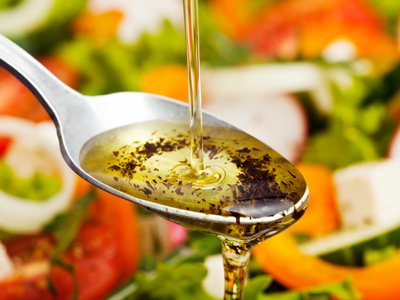
Ask the AI Tutor
Need help with Chemistry - Vegetable Oils and Their Uses (AQA)? Ask our AI Tutor!
AI Tutor - Lucy
Connecting with Tutor...
Please wait while we establish connection

Vegetable oils are often used in salad dressings.
Chemistry - Vegetable Oils and Their Uses (AQA)
Vegetable oils are important in cooking, fuels and chemistry. In this GCSE quiz you explore how oils are extracted, processed and turned into everyday products.
1 .
Why do foods cooked in vegetable oils usually contain more energy than foods cooked by other methods?
They have been subjected to higher temperatures and food holds on to the extra energy
Some of the oil remains on and in the food
They pick up energy from the other foods they are cooked with more easily in the oil
They don't cool off as quickly
During cooking using vegetable oils, some of the oil replaces water in the cells of the food as well as remaining on the surface. Water has zero food energy value but cooking oils have high energy contents
2 .
Why does food cook faster in vegetable oils than in boiling water?
The water gets into the food, slowing down the cooking
Oil is a chemical and chemicals cook things faster than just water can
They have higher boiling points than water
Vegetable oils act as catalysts
Kinetic theory meets cooking! Cooking is simply a way of making chemical changes in food to alter taste and texture. Chemical reactions go faster at higher temperatures
3 .
An emulsifier must be added to make an emulsion (such as paint, skin cream or mayonnaise) stable. Which of the following are the characteristics of a good emulsifier?
Does not form chemical bonds with oils, fats or water
Forms chemical bonds with oils and fats only
Forms chemical bonds with water only
Forms chemical bonds with oils and fats and water
The molecules that make good emulsifiers have one end that bonds with water (hydrophilic) and the other end bonds with oils and fats (hydrophobic). Lecithin is a natural emulsifier commonly used in foods
4 .
Unsaturated oils usually take what form at room temperature?
Unsaturated oils are solids at room temperature
Unsaturated oils are liquids at room temperature
Unsaturated oils are gases at room temperature
Unsaturated oils are emulsions at room temperature
Saturated oils tend to be more solid than equivalent unsaturated oils, which are usually liquids at room temperature
5 .
Why is eating a diet mainly of food cooked in vegetable oils unhealthy?
The oils contain impurities
You can only cook foods that are already high in calories in oils
The high temperatures used for cooking destroy any nutrients in the food
The extra calories can make you overweight
Vegetable oils are high in calories so it is easy to put on weight if you don't exercise a lot more
6 .
Oils and fats can be termed saturated or unsaturated. Unsaturated means what?
All of the water has been removed dusring processing
They won't mix with water
There are no carbon to carbon double bonds in the molecule
There is at least one carbon to carbon double bond in the molecule
As with the alkenes, unsaturated oils and fats will decolourise bromine water
7 .
Which parts of a plant are usually used as the source of vegetable oils?
Leaves only
Flowers and stems
Fruits, seeds and nuts
Roots
Oils can be extracted from flowers but these yield much smaller amounts and often more aromatic oils
8 .
What chemical is needed to turn vegetable oil into margarine?
Hydrogen
Sulfur
Carbon
Oxygen
The process is called hydrogenation and is carried out at a high temperature (600oC) using a catalyst (nickel)
9 .
What is an emulsion?
A type of paint
A mixture of oil and water
Something that is used for moisturising the skin
Something that is only used in cooking
When an oil and water are mixed together, tiny droplets of one liquid spread through the other. In time, an emulsion will separate - the water and oil do not mix permanently and end up as layers
10 .
What are the two methods of extracting vegetable oils?
Distillation and pressing
Filtration and pressing
Distillation and filtration
Centrifuging and pressing
Pressing is usually used to extract the more 'traditional' oils like olive oil
**Unlimited Quizzes Await You! 🚀**
Hey there, quiz champ! 🌟 You've already tackled today's free questions.
Ready for more?
Ready for more?
🔓 Unlock UNLIMITED Quizzes and challenge yourself every day. But that's
not all...
not all...
🔥 As a Subscriber you can join our thrilling "Daily Streak" against other
quizzers. Try to win a coveted spot on our Hall of Fame Page.
quizzers. Try to win a coveted spot on our Hall of Fame Page.
Don't miss out! Join us now and keep the fun rolling. 🎉
**Unlimited Quizzes Await You! 🚀**
Hey there, quiz champ! 🌟 You've already tackled today's free questions. Ready for more?
🔓 Unlock UNLIMITED Quizzes and challenge yourself every day. But that's not all...
🔥 As a Subscriber you can join our thrilling "Daily Streak" against other quizzers. Try to win a coveted spot on our Hall of Fame Page.
Don't miss out! Join us now and keep the fun rolling. 🎉






